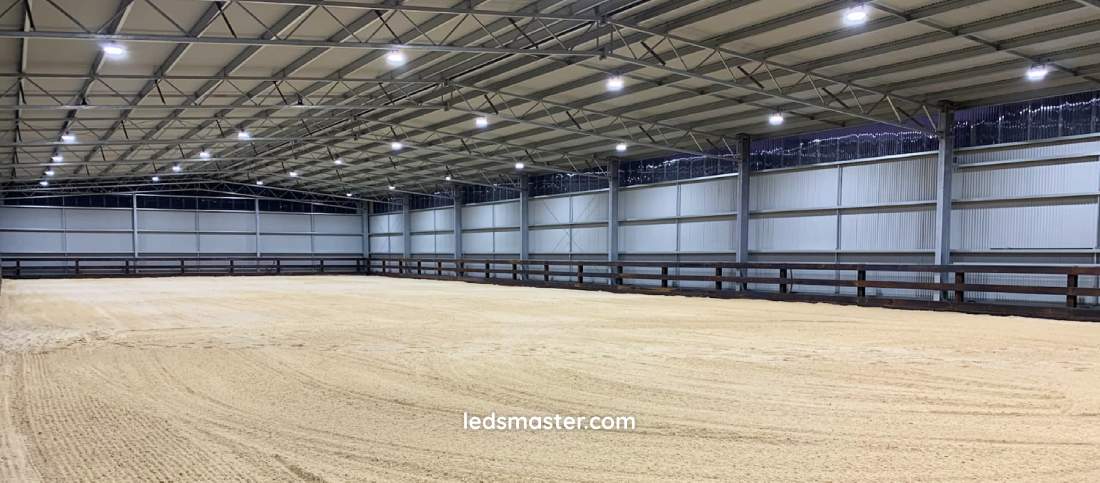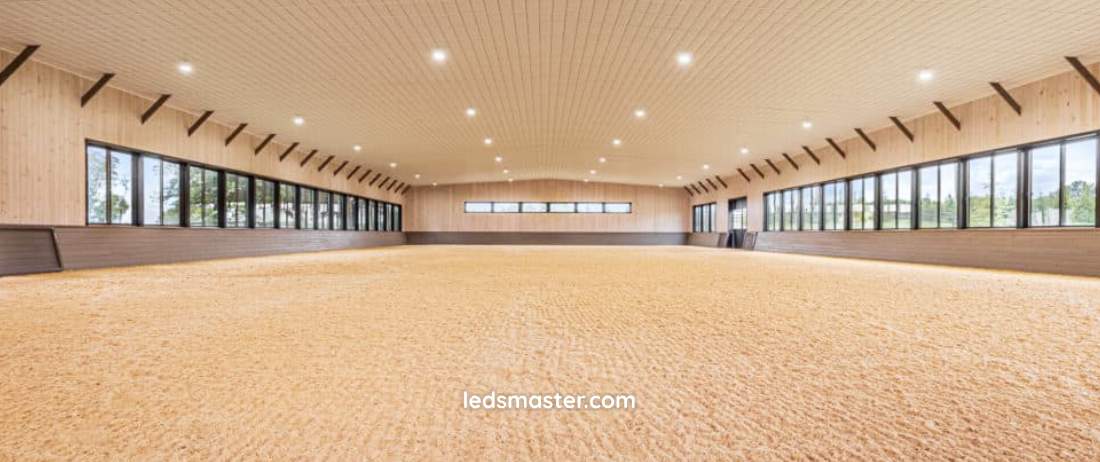Our indoor riding arena lighting products are designed to provide optimal illumination for equestrian activities, ensuring safety and performance. Featuring advanced LED technology, our lights offer high brightness with minimal energy consumption. The uniformity of light distribution is a key highlight, eliminating dark spots and shadows to create a consistent, well-lit environment. This uniformity ensures riders and horses can see clearly, reducing the risk of accidents.
Whether for training, competitions, or recreational riding, proper illumination is essential for both horse and rider. This article delves into the intricacies of indoor riding arena lighting, highlighting key aspects such as uniformity, installation, and maintenance. We will explore how to perfectly illuminate an indoor riding arena, ensuring it meets the highest standards of safety and performance.
Get your complimentary lighting design today
Table of Contents
ToggleFirst and foremost, it ensures the safety of both riders and horses. Poorly lit arenas can lead to accidents and injuries, as shadows and dark spots can obscure obstacles and uneven surfaces. Adequate lighting also enhances the performance of riders and horses by providing clear visibility, allowing for precise movements and accurate assessment of surroundings.
Moreover, good lighting conditions are essential for the mental well-being of horses. Horses have a different visual spectrum compared to humans, and inadequate lighting can cause stress and anxiety. Consistent and uniform lighting helps create a calm and comfortable environment, promoting better performance and overall health.
Uniformity is a critical aspect of indoor riding arena lighting. It refers to the even distribution of light across the entire arena, eliminating dark spots and shadows. Achieving uniform illumination ensures that every part of the arena is equally lit, providing a safe and consistent environment for riders and horses.
To achieve uniform lighting, it is essential to consider the placement and number of light fixtures. The layout should be designed to minimize overlap and ensure even coverage. High-quality LED lights are often recommended for their ability to provide consistent brightness and energy efficiency. Additionally, using lights with a wide beam angle can help distribute light more evenly across the arena.

Selecting the appropriate lighting fixtures is crucial for achieving optimal illumination in an indoor riding arena. LED lights are the preferred choice due to their numerous advantages. They are energy-efficient, long-lasting, and provide superior brightness compared to traditional lighting options. LED lights also produce less heat, reducing the risk of overheating and ensuring a comfortable environment for both riders and horses.
When choosing LED lights, it is important to consider the color temperature. A color temperature between 5000K and 6000K is ideal for indoor riding arenas as it mimics natural daylight, providing a clear and vibrant light. This helps riders see obstacles and details more clearly, enhancing their performance and safety.
The size and layout of the arena will determine the number and placement of light fixtures. Larger arenas may require more lights to ensure uniform coverage, while smaller arenas may need fewer lights.
Different activities within the arena may require varying levels of illumination. For example, training sessions may need lower light levels, while competitions and events may require higher levels of brightness. It is important to assess the specific lighting requirements and adjust the lighting design accordingly.
The height at which lights are installed plays a significant role in achieving uniform illumination. Lights should be positioned at a height that minimizes shadows and ensures even coverage. It is recommended to install lights at a height of at least 16 feet to achieve optimal results.
Proper placement and angles of light fixtures are crucial for minimizing glare and shadows. Lights should be strategically positioned to cover the entire arena without creating blind spots. Using lights with adjustable angles can help achieve the desired lighting effect.
Installing lighting controls, such as dimmers and timers, allows for flexibility and customization of lighting levels. This enables riders to adjust the lighting according to their specific needs and activities, ensuring optimal visibility and comfort.

Selecting the right type of lighting for an indoor riding arena is crucial for ensuring adequate illumination and safety. Various lighting options are available, each with its own set of advantages and applications. Below are some of the most commonly used types of lighting in indoor riding arenas.
High bay lights are a popular choice for indoor riding arenas, particularly those with high ceilings. These lights are designed to illuminate large spaces efficiently and uniformly. High bay lights are typically mounted at heights ranging from 15 to 40 feet, making them ideal for arenas with tall ceilings. High bay lights provide bright and intense illumination, ensuring that the entire arena is well-lit. Modern LED high bay lights are highly energy-efficient, reducing electricity consumption and operational costs. Additionally, these lights are designed to withstand the rigors of indoor arenas, including dust and vibrations. One of the main benefits of high bay lights is their ability to offer uniform light distribution, which minimizes shadows and dark spots.
Flood lights are another common type of lighting used in indoor riding arenas. These lights are known for their wide beam angles, which help to cover large areas effectively. Flood lights can be mounted on walls, ceilings, or poles, depending on the arena’s design and layout. Flood lights provide broad illumination, making them suitable for large arenas. Their versatility allows them to be used both indoors and outdoors, offering flexibility in lighting design. Many flood lights come with adjustable angles, allowing for precise control over the direction and spread of light. This type of lighting delivers bright and clear illumination, enhancing visibility for both riders and spectators.
LED panels are becoming increasingly popular in indoor riding arenas due to their sleek design and efficient lighting capabilities. These panels can be mounted on ceilings or walls, providing even and glare-free illumination. LED panels offer uniform light distribution, reducing shadows and creating a consistent lighting environment. They consume less energy compared to traditional lighting options, making them a cost-effective choice. Additionally, LED panels have a long lifespan and require minimal maintenance. The slim and modern design of LED panels enhances the overall aesthetic appeal of the arena.
Track lighting systems consist of multiple light fixtures mounted on a continuous track. This type of lighting is highly customizable, allowing for adjustable positioning and angling of individual lights. Track lighting offers flexibility in terms of light placement and direction, making it easy to highlight specific areas of the arena. These systems are relatively easy to install and can be modified as needed. Track lighting allows for targeted illumination, which can be beneficial for specific training or performance areas. The sleek and contemporary design of track lighting systems can enhance the visual appeal of the arena.
Recessed lighting involves lights being installed into the ceiling, creating a clean and unobtrusive look. This type of lighting is ideal for arenas that prioritize aesthetics and streamlined design. Recessed lights are unobtrusive and blend seamlessly with the ceiling, maintaining a clean and uncluttered appearance. These lights provide even and uniform illumination, reducing shadows and glare. Modern recessed lights, especially LED variants, are energy-efficient and long-lasting. Recessed lighting requires minimal maintenance and has a long operational life.
Wall-mounted lights are typically used to provide supplementary lighting in indoor riding arenas. They can be positioned strategically along the walls to enhance the overall illumination and reduce shadows. Wall-mounted lights are especially useful in arenas with lower ceilings where high bay lights might not be suitable. These lights can help highlight specific areas such as entrances, exits, or particular training zones. Wall-mounted lights also add an additional layer of lighting, contributing to the overall brightness and uniformity of the arena.
Lighting plays a significant role in equestrian training and competitions. Proper illumination allows riders to see obstacles and cues clearly, enabling precise movements and effective training sessions. In competitions, lighting enhances the visibility of both riders and judges, ensuring fair assessments and accurate scoring.
Furthermore, well-lit arenas create a visually appealing environment for spectators. Bright and uniform lighting enhances the overall experience, allowing spectators to fully appreciate the skills and performances of riders. This can contribute to the success and popularity of equestrian events.
Energy efficiency is a key consideration in indoor riding arena lighting. LED lights are highly energy-efficient, consuming significantly less electricity compared to traditional lighting options. This not only reduces operational costs but also contributes to environmental sustainability.
In addition to using energy-efficient lighting fixtures, incorporating smart lighting systems can further enhance energy efficiency. Smart lighting systems utilize sensors and controls to optimize lighting levels based on occupancy and natural light availability. This ensures that lights are only used when needed, minimizing energy wastage and reducing the arena’s carbon footprint.
Beyond functionality, indoor riding arena lighting can also enhance the aesthetic appeal of the space. Thoughtfully designed lighting can create a visually pleasing environment, making the arena more inviting and enjoyable for riders and spectators alike.
Using a combination of different lighting techniques, such as uplighting and accent lighting, can add depth and dimension to the arena. Highlighting architectural features, such as beams and trusses, can create a visually striking effect. Additionally, incorporating color-changing lights can add a dynamic element, allowing for customized lighting schemes for different events and occasions.
Achieving uniform illumination through the proper placement and selection of lighting fixtures is essential for creating a safe and consistent environment for riders and horses. By following best practices in lighting design, installation, and maintenance, indoor riding arenas can provide optimal visibility and comfort for all equestrian activities.